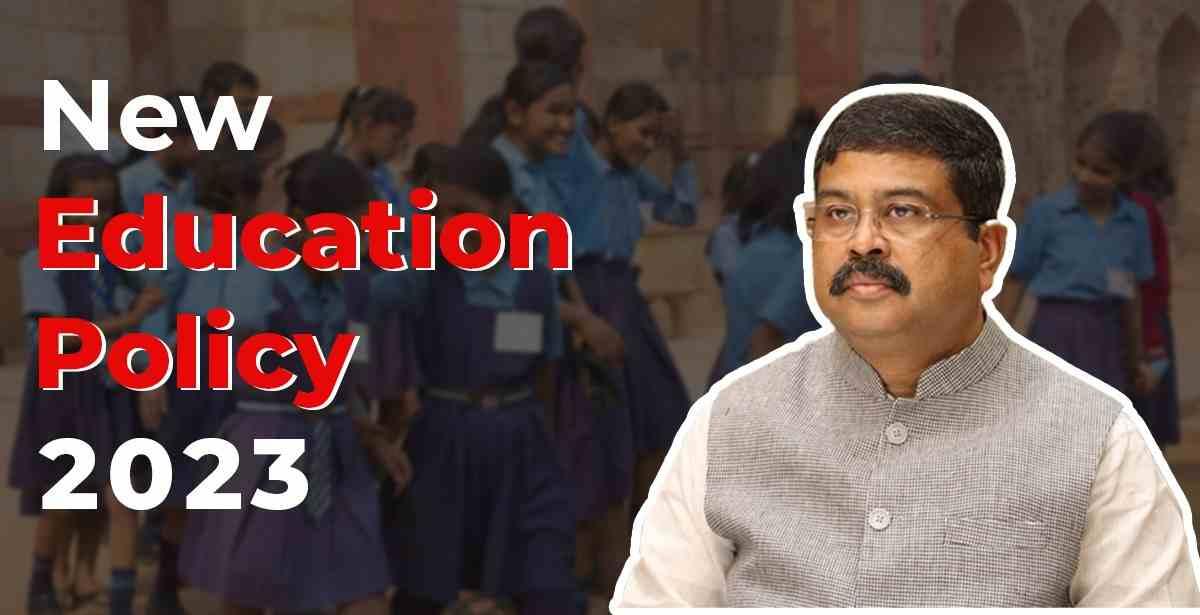

Jagpreet
03 December, 2021

Table of Contents
The “New National Education Policy (NEP)”, which was approved by the Union Cabinet, is expected to bring a flurry of reforms, ranging from school curriculum reductions to the abolition of MPhil programs.
The NEP aspires to develop an education system that directly contributes to the country’s transformation by delivering high-quality education to all citizens and developing India into a global knowledge superpower.
The new education policy was adopted by the Modi government. The 10 + 2 structure has been fully eliminated in the new education policy. Our country’s educational curriculum has been based on 10 + 2, but it will soon be based on 5+ 3+ 3+ 4. This means that one-half is from primary to second grade, the second portion is from third to fifth grade, the third part is from sixth to eighth grade, and the last part is from ninth to 12th grade.
We’ll provide you with a quick overview of the New Education Policy 2021-2023, including the Scheme Benefits and key Features.
| NEW EDUCATION POLICY 2023 – Overview | |
| Name of Scheme | New Education Policy 2021 (NEP) |
| in Hindi Language | नईशिक्षानीति |
| Name of Ministry | Union Cabinet Minister for Human Resource Development, Government of India |
| HRD Minister | Dr. Ramesh Pokhriyal Nishank |
| Launched by | Central Government of India |
| Beneficiaries | Students of India |
| Major Benefit | Provide New Reforms and Infrastructure In India |
| New Education Policy 2021 2020 Launched Date | 29 July 2020 |
| NEP 2020 implementation date | Will be available soon |
| Scheme Objective | Education System Reform |
| Scheme under | State Government |
| Name of State | All India |
| Post Category | Scheme/ Yojana |
| Official Website | https://www.mhrd.gov.in |
The Indian government’s New Education Policy is referred to as NEP. It was last modified in 1992 after being drafted in 1986. The Modi-led BJP government vowed in its election manifesto to create a new education policy, or NEP, to bring about changes in the education sector.
In July 2020, the Union Cabinet of India approved the New National Education Policy (NEP) with the aim to bring modern reforms in the Indian education system from the school to the college level. This policy stands on the ideology to make India a ‘global knowledge superpower.’ In addition to this, it was with the introduction of NEP in 2020 that the Ministry of Human Resource Development was renamed to the Ministry of Education.
The new National Education Policy is based on the pillars of Access, Equity, Quality, Affordability, and Accountability. It aims to make both school and college education more holistic, multidisciplinary, and flexible, which aligns with the 2020 agenda for sustainable development.
Also Read: Are You Feeling Stuck in Your Current Job and Want Professional Growth?
Up until the introduction of the New National Education Policy in 2020, there were many pitfalls in the Indian education system. Memorisation was prioritised more over the understanding of concepts. In addition to this, the presence of multiple boards was a big issue. Each board had different learning methods for different skills, and then every student had to take the same standardised board exam.
Furthermore, in the past years, more emphasis was laid on learning or mastering traditional subjects and less on developing vocational skills. In the new education policy, all the pitfalls and limitations of the Indian education system are taken care of. Moreover, the policy intends to bridge the gap between vocational and formal education.
Also Read: Why an Online MBA is a Game Changer for Professionals
A panel of specialists, led by former ISRO chief K Kasturirangan, discussed the difficulties and adjustments that need to be made in the Indian education system, which included everything from school to college to recruitment. These proposals were gathered, and the Ministry then approved them.

The New Education Policy extends compulsory schooling from the age bracket of 6-14 years to 3-18 years. The NEP includes three years of previously unrecognized pre-schooling for children aged 3-6 years in the school curriculum. The new system will include 12 years of formal education and three years of Anganwadi/pre-school education.
The 10+2 school curriculum framework will be replaced with a 5+3+3+4 curricular structure corresponding to ages 3-8, 8-11, 11-14, and 14-18 years, respectively, with an emphasis on Early Childhood Care and Education (ECCE).
The NEP emphasizes pupils’ native language as the medium of teaching while adhering to the “three-language formula” and ensuring that no language is imposed on anyone. The NEP simply suggests using the mother tongue as a medium of instruction rather than making it mandatory.
According to the policy paper, children learn and grasp non-trivial topics faster in their native language.
The home language, mother tongue, local language, or regional language will be used as the medium of instruction until at least Grade 5, but preferably until Grade 8 and beyond. Following that, wherever practicable, the home or local language will be taught as a language. “Both public and private schools will follow this,” the regulation adds.
The Higher Education Commission of India (HECI) will be established as a single umbrella body for all higher education in India, excluding medical and legal education. Regulation, accreditation, and academic standards will all be governed by the same set of rules for public and private higher education institutions.
In 15 years, the government will phase down college affiliation, and a stage-by-stage procedure for providing colleges with graded autonomy will be formed.
There would be no formal distinctions between arts and sciences, curricular and extra-curricular activities, or vocational and academic programs under NEP 2020. Students can choose from a variety of disciplines throughout the streams. Internships will be included in vocational education, which will begin in sixth grade.
Under the NEP, undergraduate degrees will last three or four years, with several exit alternatives available during that time. After one year of study in a topic or field, including vocational and professional fields, colleges will be required to award a certificate, a diploma following two years of study, or a Bachelor’s degree after a three-year program.
The government will also create an Academic Bank of Credit to store academic credits earned at various HEIs digitally so that they can be transferred and counted toward a final degree.
Finally, based on the foregoing points, we can conclude that this policy implements much-needed adjustments. There was no uniform system in place, which has now been eliminated. It has more transparency and a single national agency in charge of overseeing the whole education system in the country.
NEP 2020 focuses on bringing universal access to school education to ensure the holistic development of students right from the beginning. According to this policy, students’ progress and their learning capacity will be tracked timely. Students will be given access to different learning modes, like formal and informal teaching methods. In addition to this, the policy states that vocational education courses are to be included in the curriculum from pre-school to 12th standard. The policy is not just limited to knowledge or skills; it also emphasises the inclusion of trained counsellors and social workers in the schooling system.
FLN is a broad concept which refers to a child’s capability to read basic texts and solve basic numerical problems such as addition and subtraction. It is considered an urgent and vital prerequisite to learning. Keeping this in mind, the NEP has directed the states to prepare a plan on how to implement and achieve this in the curriculum for all primary school students by 2025.
The policy states that the school curriculum and pedagogy should aim for the holistic development of students by designing the coursework that would equip them with 21st-century skills. Students will have to study a reduced course content, which will emphasise experiential learning and critical thinking and give students the choice of subjects they wish to study. Moreover, vocational education will be made available in class 6th-8th, along with internship opportunities.
In the past years, very few students opted for higher education. So in view of this concern, the policy aims to incorporate a maximum number of students in higher education, including vocational education. The graduate enrolment ratio is expected to increase up to 50% by 2035 from 26.3% in 2018. Also, with the multiple exit options in higher education, it is expected that the student dropout rate will reduce.
The government has already taken initiatives to bring the standards of distance learning programmes at par with regular courses. Measures like online courses, digital repositories, funding for improved student services and research, and credit-based recognition of MOOCs, among others are to be taken.
National Educational Technology Forum (NETF), an autonomous body, will be started to offer a free exchange of ideas related to the usage of technology in enhancing the academic experience. This integration of technology is expected to improve the classroom processes, contribute to teacher professional development, and streamline the management of education planning.
An important aspect of the NEP 2020 is that it promotes the internationalisation of education by encouraging institutions to forge global collaborations with universities and research institutes. This will not be limited to students, faculty exchange programmes will also be encouraged. Meanwhile, the policy aims to allow top world universities to open their campuses in India.
In line with the objective of the New Education Policy, the Centre and State governments will be working in collaboration to increase investment in education. The collaboration of both houses is expected to reach 6% of GDP in regard to the education sector at the earliest in order to improve the educational infrastructure.
Since its introduction in 2020, many Indian educational institutions have adopted the pattern of the new National Education Policy. After three years of adoption, many academicians from top Indian institutions, including IITs, NITs, and IISERs, have reviewed the implementation of the policy. They have shared the roadmap of the changes and upgrades they have made in the academic system.
As reported by the Deccan Chronicle, the Director of IIT Hyderabad, Prof. B.S. Murthy shared that the students were given a semester break with 6 credits to pursue innovative ventures. Their institution intended to promote entrepreneurship by encouraging students to pursue BUILD (Bold & Unique Ideas Leading Development) projects. On the other hand, the Vice Chancellor of the University of Hyderabad, Prof. B. Jagdeeshwar Rao, said that NEP measures have enabled students to pursue two programmes simultaneously.
The adoption of an open curriculum with transdisciplinary course patterns, including flexibility in electives, has led to the enhancement of skill development and community-oriented projects. This is what Prof. Satyanarayana, IIT – Tirupati, said in a press conference. According to him, this will play a crucial role in nation-building. Prof. Rajesh Viswanathan of the reputed Indian Institute of Science Education and Research (IISER), Tirupati informed that their institution had made provisions for multiple-exit options in the BS-MS programme. This will add a holistic multidisciplinary approach to the education system, which earlier was rigid.
Also Read: Top 10 Online/Distance MBA Degree Colleges in India For Career Growth
The framework designed by NEP 2020 will bring a revolutionary change in the entire higher education ecosystem of India, but it has a few limitations, as studied by a few researchers. These are:
At this point, India’s education system is at a critical juncture, with the path not completely clear. The Indian education system must meet the needs of the progressive society with a population of over 1.4 billion. In the past years, India has surely made several changes in its academic structure; some challenges are yet to pass.
The new National Educational Policy offers a comprehensive strategy to enhance the quality of education and bridge the gap in socioeconomic disparities in Indian society. Its success calls for a robust collaboration between private and government entities. Therefore, if properly executed, NEP 2020 has the potential to shape India’s education system.
Get Free Career Guidance
